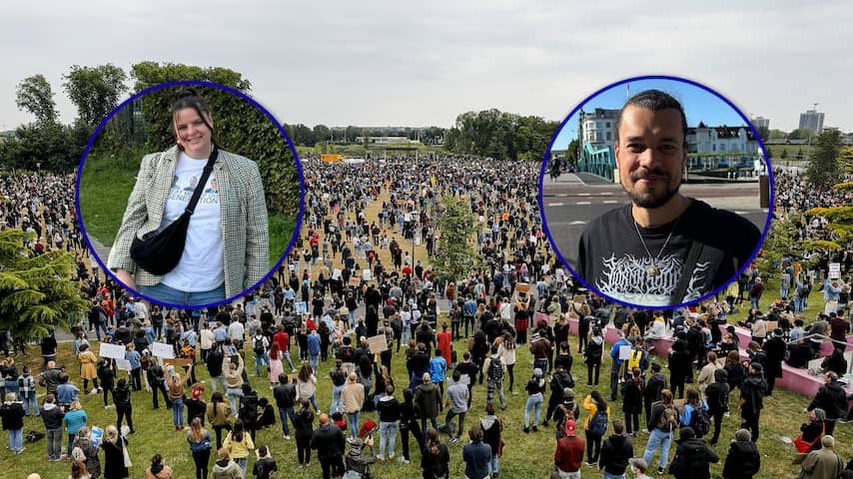
Five years after the Black Lives Matter protests, demonstrators are still grappling with the same fight against racism. The hardened political tone in the world keeps this fight relevant, according to them. Dutch protesters from back then look back and forward. “There is still a lot of work to do.”
Amy Lambeek (36) remembers the demonstrations well. “This was the moment people could make their voices heard,” she tells NU.nl about the atmosphere in the Netherlands at the time. It was a special time to protest. Due to the corona pandemic, people had to keep their distance, but keeping distance and demonstrating are not a very logical combination.
Yet it went well at Lambeek’s demonstration on June 10, 2020. “In the Nelson Mandelapark in Amsterdam there were dots where you could stand to keep your distance and there were security guards around. Thousands of people neatly adhered to the corona rules.”
The same demonstrations in the US at that time had a grim atmosphere. The police used tear gas and rubber bullets against protesters. And a number of businesses were set on fire by protesters. According to Lambeek, that was in stark contrast to the demonstration she participated in: “It was a beautiful, loving day. There were speakers everyone listened to. No unrest, no riots.”
What did the black lives matter protests entail again?
The demonstrations followed the death of 46-year-old George Floyd in Minneapolis. During his arrest on May 25, 2020, an officer knelt on Floyd’s neck for eight minutes. Floyd repeatedly said ‘I can’t breathe’ and eventually lost consciousness. He later died in the hospital.
Bystanders recorded Floyd’s arrest and shared the images on social media. This unleashed global protests against police violence and racism. In many American cities, they escalated into chaos and violence.
‘This is going to cause shit’
NU.nl reader Xan Samson (37) remembers the moment he saw the images of George Floyd’s arrest. “On May 26 around 6:30 in the morning I turned on a livestream from a YouTuber I follow. He was then covering the images of the arrest that had taken place about four hours earlier.
When I tuned in, I saw George Floyd with the officer’s knee on his neck.” That image deeply affected Samson, then a new father of a son. He knew immediately that this would cause “shit” worldwide.
In the US, racism was painfully clear, Samson believes. “It hit me enormously how the police protected Derek Chauvin, the officer who killed Floyd, with a hundred riot police in front of his house. While Floyd himself had not received any protection.”
Emotional, Samson went to Dam Square a few days later, where a spontaneous demonstration took place. “This just had to be done, it was not a question. We were fighting for something bigger. That feeling was strong.”
The Veiled Form of Racism in the Netherlands
Both Lambeek and Samson want people to realize that racism is not exclusively a problem of the US, but also plays out in the Netherlands, in a different form. “Racism in the Netherlands is more subtle. For example, it was very clear in the discussions surrounding Black Pete and how people still dismiss refugees as ‘fortune seekers’,” says Lambeek.
Her mother worked for a foundation in South Africa and saw the raw difference between black and white skin color there. It was her job to inform people and thus combat discrimination. “That racism creeps through all layers of society, also in the Netherlands. People are judged on their name, appearance or origin.”
Samson also believes that racism is more often hidden here. “In the US it happens openly, but in the Netherlands it is packaged in ‘coziness’. You hear comments like ‘It must have been a Moroccan again’. The fact that this is often laughed at makes me angry.”
Combativeness and Retreating Movement
Five years later, both protesters notice that some steps forward are not being maintained. Lambeek does see changes: “What arose around Black Pete, that only happened after those demonstrations. In many cities you no longer see him, and not on gift packaging or TV either. But the racism behind those traditions still exists, and I don’t know if that will really disappear completely.” Yet she remains combative: “Education can be changed.”
Samson finds the current political developments in the world frightening. “Wilders and others are setting a new tone. People feel strengthened in their racism and express their hatred even more openly on platforms like X. Trump, Wilders and Faber are turning back the clock, and it seems like we have to fight the battle again.”
Yet Samson thinks that the period of BLM demonstrations has yielded something positive. “Corona has helped people to reflect. Conversations arose, companies came up with inclusive slogans, although I thought that was fake at the time, but it did steer public opinion. It took a few steps forward.”
A Lasting Battle
For Lambeek and Samson one thing is clear: the fight against racism and inequality is far from over. “I hope everyone gets a fair chance,” says Lambeek. “Regardless of color or origin. My little one of three grows up with an education in which we do not name these differences, because that should be obvious.”
Samson is combative. “I will not allow us to go to a world in which hatred and friction dominate. The people who were activist then are still there. There is still so much work to do, and I will continue to fight for that.”